Physical Address
304 North Cardinal St.
Dorchester Center, MA 02124
Syphilis is a chronic systemic sexually or vertically (mother to child) transmitted infection that can be easily treated if detected early but manifests with protean clinical symptoms and significant morbidity if left unchecked.
Syphilis is caused by Treponema pallidum, a delicate, tightly spiraled, motile spirochete with finely tapered ends belonging to the family Spirochaetaceae. The pathogenic members of this genus include T. pallidum subspecies pallidum (venereal syphilis), T. pallidum subspecies pertenue (yaws), T. pallidum subspecies endemicum (bejel or endemic syphilis), and T. pallidum subspecies carateum (pinta). Because these microorganisms stain poorly and are below the detection limits of conventional light microscopy, detection in clinical specimens requires dark-field, phase contrast microscopy or direct immunofluorescent or silver staining. T. pallidum cannot be cultured in vitro. In recent years, advanced detection using nucleic acid amplification testing by polymerase chain reaction (PCR) has been increasingly used by specialized laboratories.
In addition to presentation at sexually transmitted disease clinics, patients with syphilis are increasingly seen by primary care providers in private practice settings. Two forms of syphilis occur in children and adolescents.
Acquired syphilis is transmitted almost exclusively by sexual contact, including vaginal, anal, and oral exposure. Less-common modes of transmission include transfusion of contaminated blood or direct contact with infected tissues. After an epidemic resurgence of primary and secondary syphilis in the United States that peaked in 1989, the annual rate declined 90% to the lowest ever rate by 2000. The total number of cases of primary and secondary syphilis has subsequently rebounded since 2000, particularly among men who have sex with men and men and women with HIV. Despite a decrease among women for almost a decade, their rates increased every year from 2004 to 2008. Cases of congenital syphilis reached an historic low in 2005 but have subsequently increased, reflecting the rates among women. Since 2012 the rates of congenital syphilis have increased to the highest since 2001 ( Fig. 245.1 ). The increase occurs across every region and all races and ethnicities.
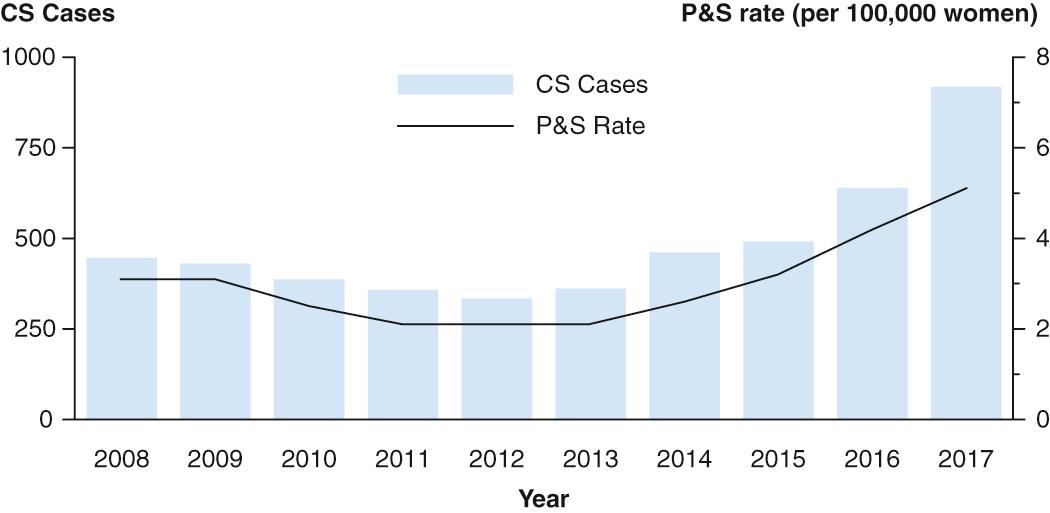
Congenital syphilis results from transplacental transmission of spirochetes or occasionally by intrapartum contact with infectious lesions. Women with primary and secondary syphilis and spirochetemia are more likely to transmit infection to the fetus than are women with latent infection. Transmission can occur at any stage of pregnancy, resulting in early fetal loss, preterm or low birthweight infants, stillbirths, neonatal deaths, or infants born with congenital disease. The incidence of congenital infection in offspring of untreated or inadequately treated infected women remains highest during the first 4 yr after acquisition of primary infection, secondary infection, and early latent disease. Maternal factors associated with congenital syphilis include limited access to healthcare, late or no prenatal care, drug use, multiple sex partners, unprotected sexual contact, incarceration, work in the sex trade, and inadequate treatment of syphilis during pregnancy. Congenital syphilis may be seen in the context of untreated, inadequately treated, or undocumented treatment prior to or during pregnancy. In addition, the mother may have been treated appropriately but did not have an adequate serologic response to therapy and the infant was inadequately evaluated or the infant had documented congenital syphilis. Confirmed cases of both acquired and congenital syphilis must be reported to the local health department.
Many persons infected with syphilis are asymptomatic for years or do not recognize the early signs of disease or seek treatment. The Centers for Disease Control and Prevention (CDC) recommends testing all pregnant women and selective testing of adolescents, based on lesions or risk factors (those with other sexually transmitted diseases including HIV, men who have sex with men, incarcerated individuals, or persons who exchange sex for money or drugs). Periods of active clinical disease alternate with periods of latency. Primary syphilis is characterized by a chancre and regional lymphadenitis. A painless papule (which may be overlooked) appears at the site of entry (usually the genitalia) 2-6 wk after inoculation and develops into a clean, painless, but highly contagious ulcer with raised borders ( chancre) containing abundant T. pallidum . Extragenital chancres can occur at other sites of primary entry and pose a diagnostic challenge. Oral lesions can be mistaken for aphthous ulcers or herpes. Lesions on the nipple can be confused with cellulitis or eczema. Adjacent lymph nodes are generally enlarged and nontender. The chancre heals spontaneously within 4-6 wk, leaving a thin scar.
Untreated patients develop manifestations of secondary syphilis related to spirochetemia 2-10 wk after the chancre heals. Manifestations of secondary syphilis include a generalized nonpruritic maculopapular rash, notably involving the palms and soles ( Fig. 245.2 ). Pustular lesions can also develop. Condylomata lata, gray-white to erythematous wart-like plaques, can occur in moist areas around the anus, scrotum, or vagina, and white plaques ( mucous patches) may be found in mucous membranes. Secondary syphilis should be considered in the differential diagnosis of virtually any rash of unknown etiology. A flu-like illness with low-grade fever, headache, malaise, anorexia, weight loss, sore throat, myalgias, arthralgias, and generalized lymphadenopathy is often present. Renal, hepatic, or ocular manifestations may be present. Meningitis occurs in 30% of patients with secondary syphilis and is characterized by cerebrospinal fluid (CSF) pleocytosis and elevated protein level. Patients with meningitis might not show neurologic symptoms. Even without treatment, secondary infection becomes latent within 1-2 mo after onset of rash. Relapses with secondary manifestations can occur during the 1st yr of latency (the early latent period). Late syphilis follows and may be either asymptomatic ( late latent ) or symptomatic ( tertiary ). Tertiary disease follows in about one-third of untreated cases and is marked by neurologic, cardiovascular, and gummatous lesions (nonsuppurative granulomas of the skin, bone, and liver, resulting from the host cytotoxic T-cell response). In the pre-antibiotic era, neurologic manifestations of tertiary syphilis ( tabes dorsalis and paresis ) were very common. The clinical course of syphilis and its tissue manifestations reflect the immunopathobiology of the host humoral and delayed-type hypersensitivity responses. A robust timeline of progression through the overlapping stages occurs in immunocompromised HIV patients
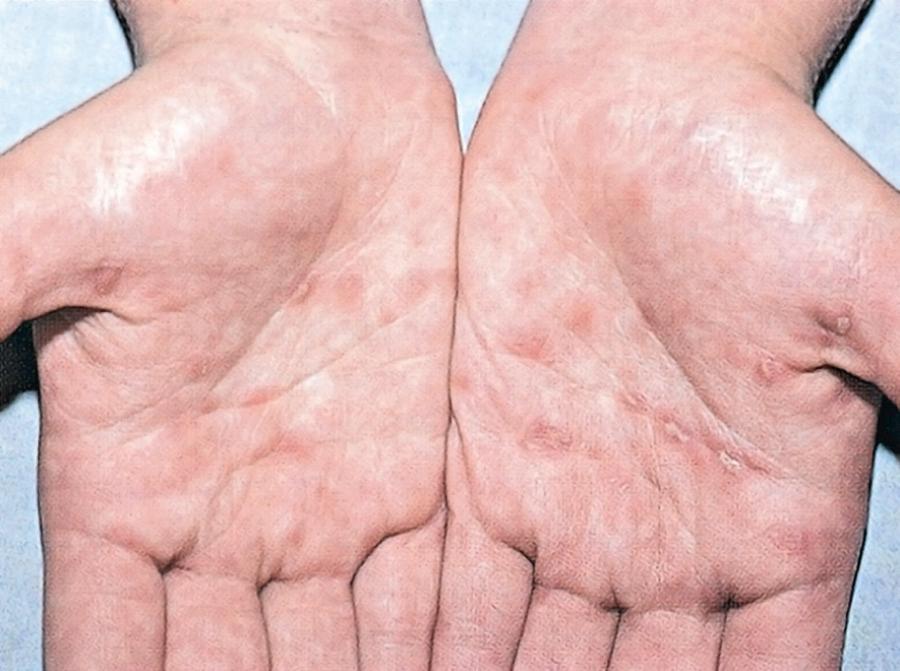
Untreated syphilis during pregnancy results in a vertical transmission rate approaching 100%, with profound effects on pregnancy outcome, reflecting obliterating endarteritis. Fetal or perinatal death occurs in 40% of affected infants. Premature delivery can also occur. Neonates can also be infected at delivery by contact with an active genital lesion. Most infected infants are asymptomatic at birth, including up to 40% with CSF seeding, and are identified only by routine prenatal screening. In the absence of treatment, symptoms develop within weeks or months. Among infants symptomatic at birth or in the first few months of life, manifestations have traditionally been divided into early and late stages. All stages of congenital syphilis are characterized by a vasculitis, with progression to necrosis and fibrosis. The early signs appear during the first 2 yr of life, and the late signs appear gradually during the first 2 decades. Early manifestations vary and involve multiple organ systems, resulting from transplacental spirochetemia and are analogous to the secondary stage of acquired syphilis. Hepato-splenomegaly, jaundice, and elevated liver enzymes are common. Histologically, liver involvement includes bile stasis, fibrosis, and extramedullary hematopoiesis. Lymphadenopathy tends to be diffuse and resolve spontaneously, although shotty nodes can persist.
Coombs-negative hemolytic anemia is characteristic. Thrombocytopenia is often associated with platelet trapping in an enlarged spleen. Characteristic osteochondritis and periostitis ( Fig. 245.3 ) and a mucocutaneous rash ( Fig. 245.4 A and B ) manifesting with erythematous maculopapular or vesiculobullous lesions followed by desquamation involving hands and feet (see Fig. 245.4 C ) are common. Mucous patches, persistent rhinitis ( snuffles ), and condylomatous lesions ( Fig. 245.5 ) are highly characteristic features of mucous membrane involvement containing abundant spirochetes. Blood and moist open lesions from infants with congenital syphilis and children with acquired primary or secondary syphilis are infectious until 24 hr of appropriate treatment.
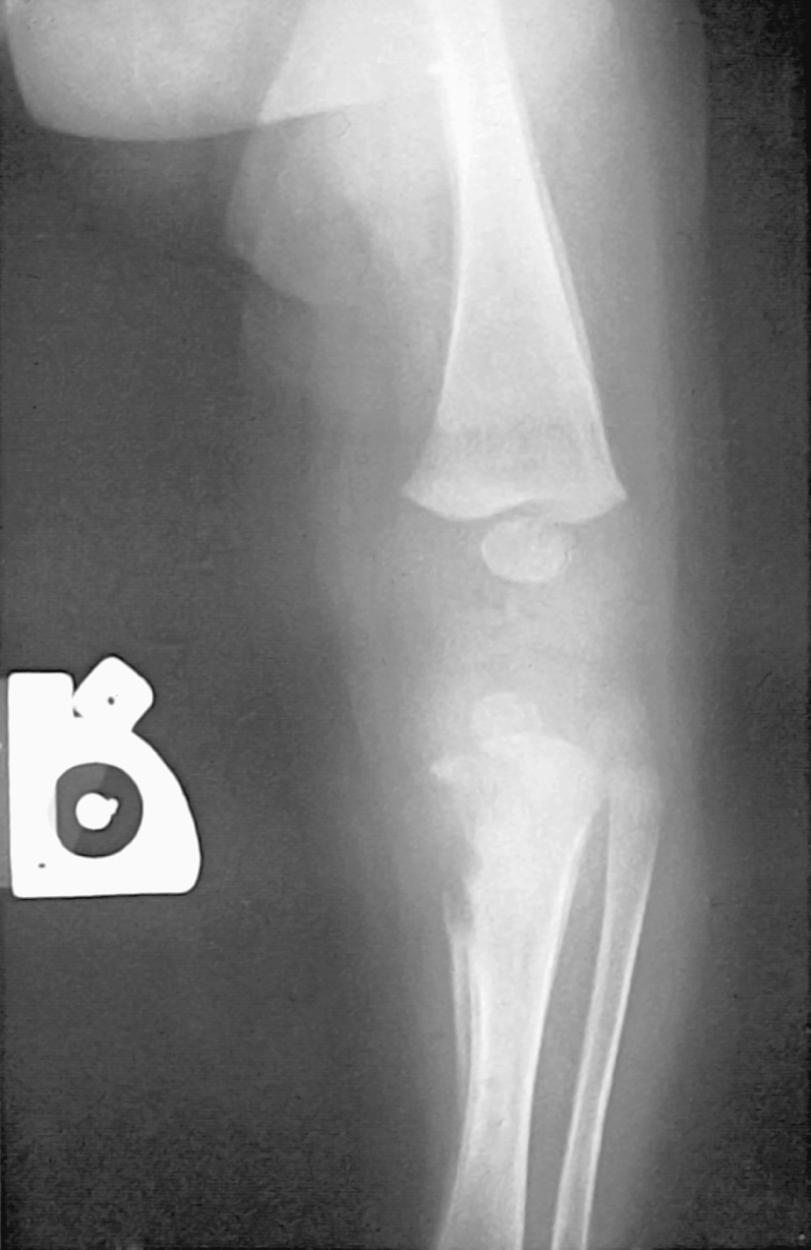

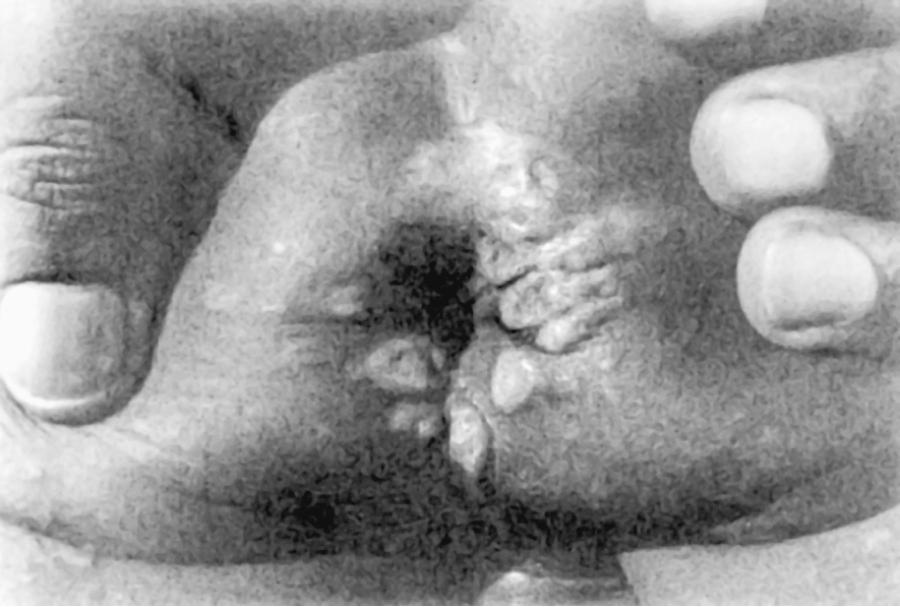
Bone involvement is common. Roentgenographic abnormalities include Wimberger lines (demineralization of the medial proximal tibial metaphysis), multiple sites of osteochondritis at the wrists, elbows, ankles, and knees, and periostitis of the long bones and rarely the skull. The osteochondritis is painful, often resulting in irritability and refusal to move the involved extremity ( pseudoparalysis of Parrot ).
Congenital neurosyphilis is often asymptomatic in the neonatal period, although CSF abnormalities can occur even in asymptomatic infants. Failure to thrive, chorioretinitis, nephritis, and nephrotic syndrome can also be seen. Manifestations of renal involvement include hypertension, hematuria, proteinuria, hypoproteinemia, hypercholesterolemia, and hypocomplementemia, probably related to glomerular deposition of circulating immune complexes. Less-common clinical manifestations of early congenital syphilis include gastroenteritis, peritonitis, pancreatitis, pneumonia, eye involvement (glaucoma and chorioretinitis), nonimmune hydrops, and testicular masses.
Late manifestations (children > 2 yr of age) are rarely seen in developed countries. These result primarily from chronic granulomatous inflammation of bone, teeth, and central nervous system and are summarized in Table 245.1 . Skeletal changes are caused by persistent or recurrent periostitis and associated thickening of the involved bone. Dental abnormalities, such as Hutchinson teeth ( Fig. 245.6 ), are common. Defects in enamel formation lead to repeated caries and eventual tooth destruction. Saddle nose ( Fig. 245.7 ) is a depression of the nasal root and may be associated with a perforated nasal septum.
| SYMPTOM/SIGN | DESCRIPTION/COMMENTS |
|---|---|
| Olympian brow | Bony prominence of the forehead caused by persistent or recurrent periostitis |
| Clavicular or Higoumenaki's sign | Unilateral or bilateral thickening of the sternoclavicular third of the clavicle |
| Saber shins | Anterior bowing of the midportion of the tibia |
| Scaphoid scapula | Convexity along the medial border of the scapula |
| Hutchinson teeth | Peg-shaped upper central incisors; they erupt during 6th yr of life with abnormal enamel, resulting in a notch along the biting surface |
| Mulberry molars | Abnormal 1st lower (6 yr) molars characterized by small biting surface and excessive number of cusps |
| Saddle nose * | Depression of the nasal root, a result of syphilitic rhinitis destroying adjacent bone and cartilage |
| Rhagades | Linear scars that extend in a spoke-like pattern from previous mucocutaneous fissures of the mouth, anus, and genitalia |
| Juvenile paresis | Latent meningovascular infection; it is rare and typically occurs during adolescence with behavioral changes, focal seizures, or loss of intellectual function |
| Juvenile tabes | Rare spinal cord involvement and cardiovascular involvement with aortitis |
| Hutchinson triad | Hutchinson teeth, interstitial keratitis, and 8th nerve deafness |
| Clutton joint | Unilateral or bilateral painless joint swelling (usually involving knees) from synovitis with sterile synovial fluid; spontaneous remission usually occurs after several weeks |
| Interstitial keratitis | Manifests with intense photophobia and lacrimation, followed within weeks or months by corneal opacification and complete blindness |
| 8th nerve deafness | May be unilateral or bilateral, appears at any age, manifests initially as vertigo and high-tone hearing loss, and progresses to permanent deafness |
* A perforated nasal septum may be an associated abnormality.
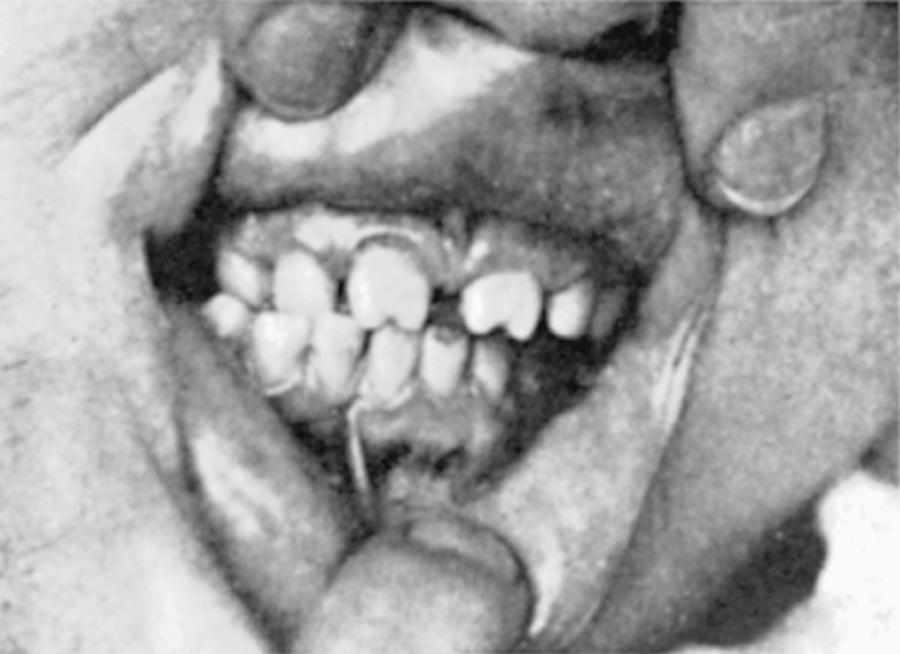
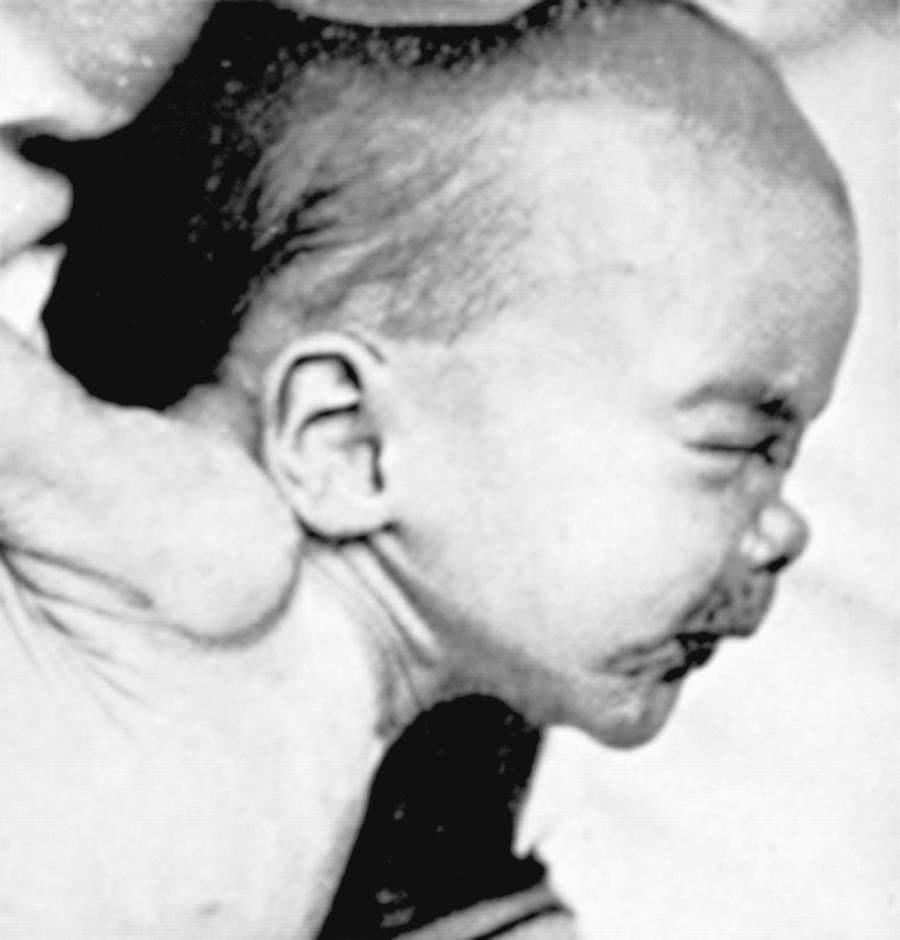
Other late manifestations of congenital syphilis can manifest as hypersensitivity phenomena. These include unilateral or bilateral interstitial keratitis and the Clutton joint (see Table 245.1 ). Other common ocular manifestations include choroiditis, retinitis, vascular occlusion, and optic atrophy. Soft-tissue gummas (identical to those of acquired disease) and paroxysmal cold hemoglobinuria are rare hypersensitivity phenomena.
Become a Clinical Tree membership for Full access and enjoy Unlimited articles
If you are a member. Log in here